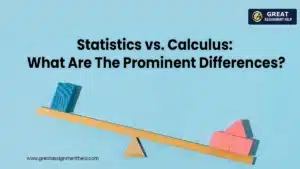Statistics and Calculus are the most useful branches of mathematics. However, most students get confused between these two important parts of mathematics. Statistics and Calculus are quite distinct subjects and they have different applications. Statistics is used in researching, forecasting, and predicting mathematical models. But, a concept of Calculus is employed in developing cell phones, national reference, and the economy. If you want to pursue graduation or higher academic programs in math and do not have a clear idea of the disparities between statistics vs. Calculus, read this blog. Here, we have conducted a comprehensive study.
A Comparative Study of the Differences between Statistics vs. Calculus
Here are the differences between Statistics and Calculus.
Statistics vs. Calculus: Concept
Here is the difference between the concepts of Statistics and Calculus:
What are Statistics?
Statistics is the branch of applied mathematics that studies the methods of gathering, examining, summarizing, presenting, and arranging data. It is used to solve scientific, industrial, or social issues. In statistics, data plays an important role. Statistics is concerned with every aspect of data, from planning data for designing surveys to conducting experiments. Statistics involves 2 significant and fundamental ideas. It includes uncertainty and variation. These ideas are determined by probability and play a significant role in statistics.
What is Calculus?
Calculus is the branch of mathematics that is concerned with uninterrupted change. Calculus is also termed infinisimal Calculus or “the Calculus of infinitesimals”. Classical Calculus is the study of continuous changes in functions. Most of these quantities are operations of time, like velocity, which is the same as a change in distance over time. The two major concepts of Calculus are:
- Derivatives: They are the calculations of the speed of change of functions at a specific point in time.
- Integrals: It refers to the calculation of the area under the curve and the collection of distinct values of a function over a range of values.
Read more: Learn How To Solve Statistics Problems Easily
Statistics vs. Calculus: Types
The branches or types of statistics are different from those of Calculus. Here are the differences:
-
Types of Statistics
Statistics are of two types:
-
Descriptive Statistics
Descriptive Statistics use an evocative summary of data. Statisticians summarize the data from the samples of the population. They use parameters like Mean or standard deviation to prepare charts, graphs, and other summarization procedures to systematize, represent, and explain data sets. Data is typically organized and presented in tables or graphs that sum up details like histograms, pie charts, bars, or scatter plots.
-
Inferential Statistics
In Inferential Statistics, statisticians interpret the significance of descriptive Statistics. After they collect, analyze, and summarize the data, the statisticians use Inferential Statistics to explain the importance of the collected data. This branch of statistics uses the probability principle to examine if the trends enclosed in the research sample can be simplified for the larger population from which the sample originally arrived. Inferential Statistics are designed to test assumptions and examine connections between variables. They also help in making predictions about the population. Also, drawing conclusions and inferences or making valid hypotheses from samples becomes easy with inferential statistics.
-
Types of Calculus
Calculus can be categorized into 4 types. It includes:
-
Basic Calculus
It is the elementary level of Calculus. Elementary Calculus is concerned with the study of functions, inverse functions, rational functions, and complex numbers.
-
Differential Calculus
This subfield of Calculus helps you to determine the slope of curves and the rate of change in measures. Limits, derivatives, functions, and parametric equations are also part of differential Calculus.
-
Integral Calculus
It is a sub-branch of Calculus that deals with the determination of the area near a curve, either above or below. The results can be obtained by learning about integrals, differential equations, and series.
-
Infinitesimal Calculus
Calculus as such was at first called “infinitesimal Calculus” or “Calculus of infinitesimals.” Therefore, infinitesimal Calculus refers to Calculus in general. It indicates values that are very close to zero or any real number.
Read more: Types of Charts in Statistics
Statistics vs. Calculus: Steps to Solving Problems
The steps for solving statistics problems are quite different from those for solving Calculus problems. The following are the differences:
- Statistics:
Following are the steps to find answers to the statistics problems:
Step 1: Find out the problem
The first step to solving the statistics problem is to determine the problem. It is also called a question or hypothetical test. Taking this step will help you analyze the parameters and population of the study and then establish further steps.
Step 2: Collect Adequate Data
The next step involves collecting data based on the hypothesis. This step is crucial to getting accurate data. Here, it is essential to determine two things:
- The population resource to study for collecting data
- The variety of methodologies to collect data, for example, questionnaires, surveys, etc.
Step 3: Analyze the Data
At this stage of solving statistical problems, examine the collected data accordingly. There are a range of tools to investigate the data. The most common of them are Microsoft Excel, Python, and R.
Step 4: Interpret the Collected Data
The fourth step to solving statistical problems involves clarifying and presenting the collected data. You can present the data through a variety of tools. Pie charts, graphs, tables, etc. are the most common presentation tools.
Step 5: Use statistical formulas
Statistical problems are resolved through statistical formulas. Therefore, learn the formulas to find out the answer. For example, to find the d mean, median, mode, or standard deviation, you must be well acquainted with the standard formulas to get the correct results.
- Calculus:
The Steps to calculate Calculus problems are as follows:
Step 1: Understand the part of the Calculus
The first step to solving Calculus problems is to understand the various parts of Calculus. Calculus studies the following:
- change
- rate of change
- growth
The rate of change indicates derivatives. Calculus is concerned with the rate. Therefore, learn the rate of change in time as compared to distance and velocity.
Step 2: Learn Calculus formulas
Derivatives and integrals have some fundamental formulas. Understand all of them with proof. Memorize and implicate them as required.
Step 3: Learn about the limits and solve the problems
An intricate function limit is mandatory. It will help intricate functions to break down complex functions into small pieces. Solve all the complicated parts of the function and add them to make a complex function easy.
Step 4: Acquaint yourself with the theorem of Calculus
Learning the fundamental theorem will help you solve Calculus problems easily and will also help you recognize the different features of Calculus. For example, if you are aware of integration and differentiation, you can recognize that they are inverses of each other.
Step 5: Practice Calculus problems
Solve the problems using the equations learned. Then keep practicing it. You may begin with the derivatives problem. After that, pick the integral problems. It will make the practice process easy.
Also read: Best Statistics Project Ideas to Get Started
Statistics vs. Calculus: Principles
The fundamental principles of statistics are completely different from those of Calculus. They are different in the following ways:
- Statistics
There are numerous basic principles of statistics that must be recognized when working on social research. Some of the most popular ones are the following:
- Central Limit Theorem: It indicates that when a large sample size has limited variance, the sample will be normally distributed, and the mean of the sample and the mean of the entire population will be equal.
- Correlation: It is a statistical measurement that highlights the degree to which 2 components are linearly related.
- Covariance: It is a calculation of the connection between 2 random components and the degree to which they change together.
- Degrees of Freedom: It indicates the maximum count of rationally independent values that may vary in a sample of data.
- Experimental effectiveness: It refers to the design and analysis of statistical experiments used in the fields of agriculture, medicine, marketing research, etc.
- Calculus
The following are the basic principles of Calculus:
- Limits and Infinitesimals: Infinitesimals indicate minute-digit numbers like values between 0 and 1. To put it another way, numbers that have less value in comparison with a positive real number are termed Infinitesimals. The concept of Calculus formulas was created at first to calculate such small values. Therefore, it can control specific limits and principles for infinitesimals.
- Leibniz Notation: The term Leibniz Notation is named after the great Mathematician and German Philosopher Gottfried Wilhelm Leibniz. Leibniz Notation uses the symbols “dx” and “dy” to discover the precise value of derivatives. The values of “dx” and “dy” are considered assumptions to calculate the further computations of any given function.
- Fundamental Theorem: The basic theorem of Calculus indicates the connection between the derivatives and their integrals.
Statistics vs. Calculus: Uses
Statistics and Calculus are used for different purposes. Here are some common examples of the distinct uses: [Change the font]
- Statistics
It is used primarily for the following purposes:
- Research: To draw inferences from a given dataset
- Economics: For the collection, processing, distribution, and examination of economic data
- Machine Learning: Machine learning technologies are based on statistical concepts like regression, correlation, modeling, etc.
- Nursing: To detect patterns in visual signs and symptoms
- Insurance: Here, the insurance-providing companies use various statistical data to analyze the amount of insurance a person needs.
- Calculus
Calculus is used for a variety of purposes in practical life. It includes the following:
- Structural Engineering: Conduct structural analysis and compute the loss of heat in buildings, intricate structural configurations, and seismic design requirements.
- Medicine: Compute the precise bacterial growth rate in a culture caused by various environmental conditions like temperature and source of food.
- Credit card payments: Setting the structure of paying credit card dues and the lowest due amount by taking into consideration interest rates, fluctuating balances, and other variables.
- Acoustics: Calculus is used for computing resonance and forced oscillation.
- Video game simulation: Calculus helps graphic designers recognize the three-dimensional models developed by altering settings.
Also read: Top Uses of Statistics in Everyday Life
Statistics vs. Calculus: Basic Formula
There is a significant difference between the formula used in statistics and that used in Calculus. Here are the most common formulas used in the two different branches of mathematics:
- Statistics
The following are the fundamental formulas used in statistics:
- Mean:.
Explanation: x = given observation; n = total number of observations.
- Median: when n = an odd number;
Explanation: Here, n = the total number of observations.
- Mode: The value that appears most frequently is the mode of the set of numbers.
- Variance: σ2 =
Explanation: x = observations mentioned; n = total number of observations.
· Standard deviation: S = σ =
Explanation: x = observations mentioned in; n = total number of observations
- Calculus
Here are the most common formulas used in Calculus:
-
Elementary Functions of Calculus
-
Hyperbolic Functions of Calculus
- d/dx six = coshx
- d/dx coshx = sin hx
- d/dx tan hx = sec h2x
- d/dx cot hx = -cosec h2x
- d/dx sec hx = -sech hx tan hx
- d/dx cosec hx = -cosec hx cot hx
-
Form functions of differential Calculus
· Constant Rule = y = c
· Constant Multiple Rule = y = cf(x)
· Power Rule = y = xn
· Generalized Power Rule = y = [f(x)]n
· Sum of Two Functions = y = f(x) + g(x)
· Difference of Two Functions = y = f(x) – g(x)
- Product Rule = y = f(x). g(x)
- Quotient Rule = y = f(x) / g(x)
- Chain Rule for Composite Functions = y = f[g(x)]; y = f(u), u = g(x)
A Tabular Representation of The Differences Between Statistics And Calculus
| Basis of comparison | Statistics | Calculus |
| Concept | Statistics is the branch of applied mathematics that studies the methods of gathering, examining, summarizing, presenting, and arranging data. It is used to solve scientific, industrial, or social issues. In statistics, data plays an important role. Statistics is concerned with every aspect of data, from planning data for designing surveys to conducting experiments. Statistics involves 2 significant and fundamental ideas. It includes uncertainty and variation. These ideas are determined by probability and play a significant role in statistics.
|
Calculus is the branch of mathematics that is concerned with uninterrupted change. Calculus is also termed infinisimal Calculus or “the Calculus of infinitesimals”. Classical Calculus is the study of continuous changes in functions. Most of these quantities are operations of time, like velocity, which is the same as a change in distance over time. The two major concepts of Calculus are:
|
| Types | There are two types of statistics: descriptive and inferential. | Calculus can be categorized into 4 types: basic, differential, integral, and infinitesimal. |
| Steps to solving problems
|
The following steps must be taken to solve statistical problems:
v Find out the problem · Collect Adequate data. · Analyze the Data · Interpret Collected Data · Use statistical formulas |
The steps to solving Calculus are:
v Understand the part of the Calculus v Learn Calculus formulas. v Learn about the limits and solve the problems. v Acquaint yourself with the theorem of Calculus. v Practice Calculus problems |
| Principles | The fundamental principles of statistics are as follows:
· Central Limit Theorem · Correlation · Covariance · Degrees of Freedom · Experimental Effectiveness |
The basic principles for solving Calculus include:
· Limits and Infinitesimals · Leibniz Notation · Fundamental Theorem |
| Uses | Statistics is used in many fields, including research, machine learning, economics, nursing, and insurance. | Calculus is primarily used in Structural engineering, medicine, acoustics, credit card payment, and video game simulation. |
Also read: Between Statistics Vs. Parameters
The Bottom Line
The discussion above shows the prominent dissimilarities between Statistics vs. Calculus. Statistics is more inclined to gather, examine, summarize, and present data. On the other hand, Calculus deals with uninterrupted change. To learn more about the differences or solve math problems based on statistics and Calculus connect with our assignment helpers. They will send you accurate solutions and assist you in submitting your math paper on due time.



